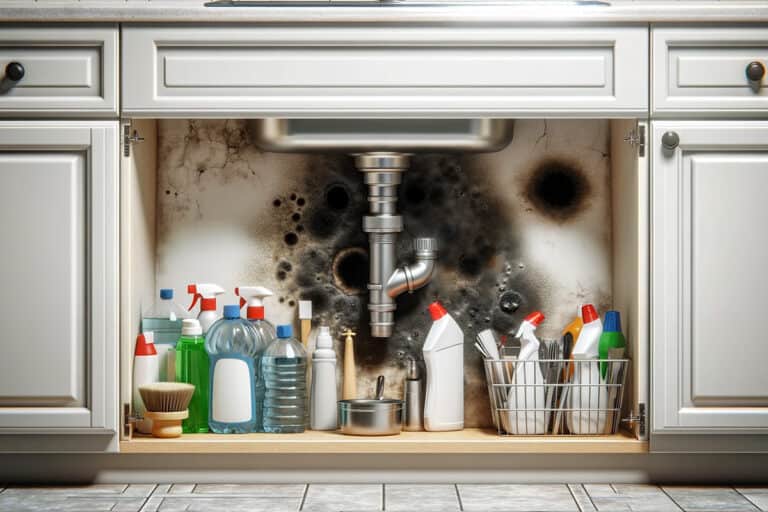Disclosure: I am compensated for purchases made through some links on this site. Click for details.
Brown mold is a type of fungus that typically appears as dark patches on surfaces prone to moisture, like wood, drywall, or tiles. As a fungus, it thrives in environments that provide organic matter, moisture, and oxygen, making homes a common battleground for brown mold infestations. Identifying brown mold is imperative for maintaining a healthy living space, as some species can have significant health impacts.
Preventing brown mold involves controlling moisture levels in the home and promptly addressing water leaks and dampness. For mold that’s already taken hold, remediation techniques range from household cleaning solutions for minor infestations to professional services for more pervasive problems. To sustain a mold-free environment, regular home maintenance and monitoring for the early signs of mold growth are essential steps in prevention.
Key Takeaways
- Brown mold is a moisture-loving fungus that can be harmful to health.
- Identifying and remedying brown mold promptly is crucial for a healthy home.
- Ongoing prevention and maintenance are key to keeping mold at bay.
Understanding Brown Mold
Brown mold represents a group of fungal species that share a common pigmentation. This section addresses the specific characteristics of brown mold, identifies typical locations as well as underlying causes for its proliferation, and distinguishes various types and species associated with this coloration.
Characteristics of Brown Mold
Brown mold is often confused with black mold due to similarities in appearance, particularly in poor lighting conditions. Its texture may vary from fuzzy to slick, and it can form distinctive spots on affected surfaces. Mold spores, which are essential for reproduction, contribute to these visual markers and are a key characteristic.
Common Locations and Causes
Brown mold commonly thrives in areas with high humidity, such as basements and bathrooms, where it feeds on materials like wood and organic matter. Prolonged water damage, leaks, or condensation create ideal conditions for mold growth. It is especially important to monitor these environments for early signs of mold to prevent extensive proliferation.
Types and Species of Mold
While there are thousands of mold species, not all take on a brown coloration. Species such as Ulocladium, which is often found following water damage, and Stemonitis, a type of slime mold that sometimes displays a brown color, are often encountered. Cladosporium, another common household mold, can appear brown and thrives in both warm and cold conditions, making it a pervasive intruder.
Health Impacts of Mold Exposure
Exposure to brown mold can have significant health impacts, particularly for those with allergies, asthma, or compromised immune systems. This section discusses the specific problems that can arise from such exposure, ranging from allergic reactions to more serious respiratory issues.
Allergic Reactions to Brown Mold
Brown mold can trigger allergic reactions in sensitive individuals. Symptoms often include sneezing, runny or stuffy nose, and skin rashes. Specific types of toxic mold, such as black mold, may lead to more severe allergies, especially in children and the elderly, due to their more vulnerable immune systems.
Asthma and Respiratory Problems
Mold, including brown varieties, can exacerbate asthma symptoms and cause other respiratory problems. Individuals may experience coughing, wheezing, and difficulty breathing. For those with asthma, exposure to mold spores can lead to increased frequency and severity of attacks, and it poses a particular risk for respiratory problems in the elderly and those with chronic lung diseases.
Mold and the Immune System
For those with compromised immune systems, including individuals undergoing chemotherapy or living with HIV/AIDS, mold exposure can be particularly hazardous. It can lead to lung infections and a prolonged illness, as their body is less capable of fighting off mold spores. Understanding the potential health risks of mold is crucial, especially for individuals with existing health conditions or compromised immune systems.
Mold Identification and Prevention
Accurate mold identification and consistent prevention strategies are critical for maintaining a healthy home environment. Experts underscore the importance of recognizing the presence of mold and implementing measures to prevent its growth.
Detecting Mold in Homes
Detecting brown mold in homes requires vigilance, as it often presents itself as a discolored patch on various surfaces such as walls, ceilings, or carpets. Homeowners should be on the lookout for telltale signs like a musty odor, which is a strong indicator of mold presence. Engaging a professional mold inspector can confirm suspicions, as they are trained to identify different mold types and the potential risks associated with them.
If visual signs are present, addressing them promptly is imperative since mold can proliferate quickly under the right conditions. Regular inspections in moisture-prone areas, such as bathrooms and basements, can help in early detection.
Preventing Mold Growth
To prevent mold growth, controlling moisture inside the house is key. Homeowners are advised to ensure adequate ventilation in moisture-rich areas including kitchens and bathrooms, which can curb the proliferation of mold spores. Using a dehumidifier in areas with high humidity levels can also reduce the moisture in the air significantly, making it less hospitable for mold.
It’s also essential to fix any leaks promptly and to dry wet areas within 24-48 hours to prevent mold from taking hold. Surfaces that are prone to moisture can be treated with mold-resistant products to offer a protective barrier. Educating oneself on proper home maintenance techniques can go a long way in mold prevention and creating a safe and healthy living environment.
Mold Remediation Techniques
When addressing a mold problem, one can select either professional mold removal services or do-it-yourself cleaning methods based on the severity and size of the infestation. Both approaches aim to remove mold effectively and prevent its return, but the choice depends on whether the situation requires expert intervention or can be managed with home remedies.
Professional Mold Removal
Professional mold remediation involves a thorough process carried out by trained experts to ensure the mold is completely eradicated from the affected area. The first step is usually an assessment, where professionals identify the extent and type of mold present. They may use advanced equipment such as HEPA air filters and vacuum systems, and in some cases, contaminated materials might require safe disposal. Specialists in mold removal adhere to strict safety protocols to avoid cross-contamination and ensure that mold spores do not spread during the remediation process.
Do-It-Yourself Mold Cleaning
For less severe mold problems, one may consider a do-it-yourself approach using common household products. Cleaning solutions such as vinegar or bleach can be effective against surface mold when used properly. It’s essential to wear protective gear, like gloves and masks, and to ensure the area is well-ventilated during the cleaning process. However, these methods may not be sufficient for pervasive mold infestations or if the mold is in hard-to-reach areas. In such cases, it’s better to consult a professional.
Prevention and Maintenance
The most effective strategy in combating brown mold growth centers on keeping indoor environments dry and well-ventilated. Specific interventions can mitigate the risks associated with high humidity and stagnant air, which are prime factors for mold proliferation.
Controlling Indoor Moisture
To maintain a mold-resistant home, monitoring and managing indoor humidity is crucial. It is recommended to keep humidity levels below 60%, and ideally between 30-50%. This can be accomplished by:
- Using dehumidifiers: Placing dehumidifiers in areas prone to moist air helps reduce condensation.
- Fixing water leaks promptly: Leaks from pipes or roofs should be addressed immediately to prevent mold growth.
- Insulating pipes: This prevents condensation by keeping the pipe surface temperature close to that of the water inside.
Effective water management also includes regular inspections for any signs of moisture buildup, particularly around bathrooms and kitchens where water usage is frequent.
Improving Air Circulation
Adequate ventilation is essential to prevent mold from taking hold due to poor air circulation. Implementing the following measures can enhance airflow and reduce mold risks:
- Use exhaust fans: Installing exhaust fans in high-humidity areas such as bathrooms and kitchens can expel moist air.
- Open windows: Whenever weather permits, open windows to allow fresh air to circulate and dilute humid indoor air.
- Maintain HVAC systems: Regular maintenance of heating, ventilation, and air conditioning systems ensures they are circulating air efficiently and reducing pockets of warm, stagnant air where mold can thrive.
Ensuring that furniture and other home items do not obstruct vents or air returns also plays a role in maintaining proper air circulation throughout different spaces.
Conclusion
Brown mold includes several species that thrive mainly in damp environments and on materials rich in cellulose. It’s often found on wood surfaces but can also be present on walls and tiles. Managing moisture through home maintenance can preclude mold growth and safeguard a home’s structural integrity.
Health implications can vary; some types of brown mold, such as Cladosporium, may induce allergies and asthma. In contrast, others, like Mucor, pose serious health risks. Regular inspection and cleaning can reduce the presence of brown mold and its associated health concerns.
Homeowners should be aware of mold types and promptly address leaks and humidity issues to maintain a healthy living environment. Professional remediation may be necessary for extensive mold problems, as experts possess the proper tools and knowledge for effective mold removal.


